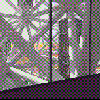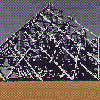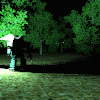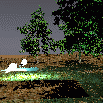 |
In one of 12,000 apartments inside one
of the habitation modules of the arcology seen below and on my
raytracing page, 256x256, 120 frames, two ambient
bounces, 40 hours on an old SGI Indigo, 460KB |
 |
Flying through a latticework arcology,
also seen on my raytracing page, 128x128, 100 frames, no ambient
bounces (i.e. no radiosity calculation), an hour or two on old
Indigo, 434KB |
 |
Third rocket shot, at night, with
launcher heavy gear, 256x256, 50 frames, no ambient bounces, several
jitter options set, 15 hours on same Indigo, 280KB |
 |
Second rocket shot, more scenic
test of sh scripts controlling firing and trajectory. 256x256,
80 frames, no ambient bounces, 20 hours on old SGI Indigo,
803KB |
 |
Rocket shot, simply a test of
whether a light source can act as a good exhaust plume. See for
yourself. 304x200, 100 frames, 3 ambient bounces, less than 1 hour
rendering time on an HP 715/64! 311KB |
 |
Soleri's Linear city, only a small
section of it, though. This movie is 240x160, 200 frames, 2 ambient
bounces, but only took 6 hours or so on an unloaded HP715/64.
495KB |
 |
Spinning CAEN logo, went back to action
scenes, a most cool one...watch for the Enterprise! 10 hours on
HP735/99, 160x120, 180 frames, 163KB, 511 KB version |
 |
EECS movie, take 3, first movie using
radiosity techniques, 240x160, 200 frames, 3 ambient bounces, took
all damn weekend! 415 KB |
 |
EECS movie, take 2, 200 frames, 160x120,
daylight calculation, 16 hours on HP715/64, 167 KB |









